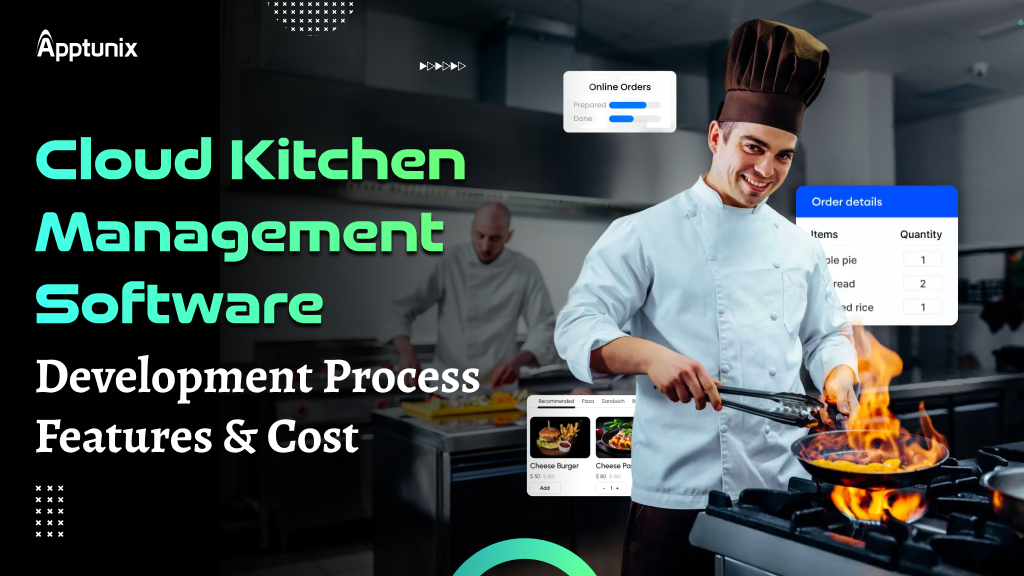
Cloud Kitchen Management Software Development: Features, Cost, and How to Build
51 Views 13 min November 26, 2025

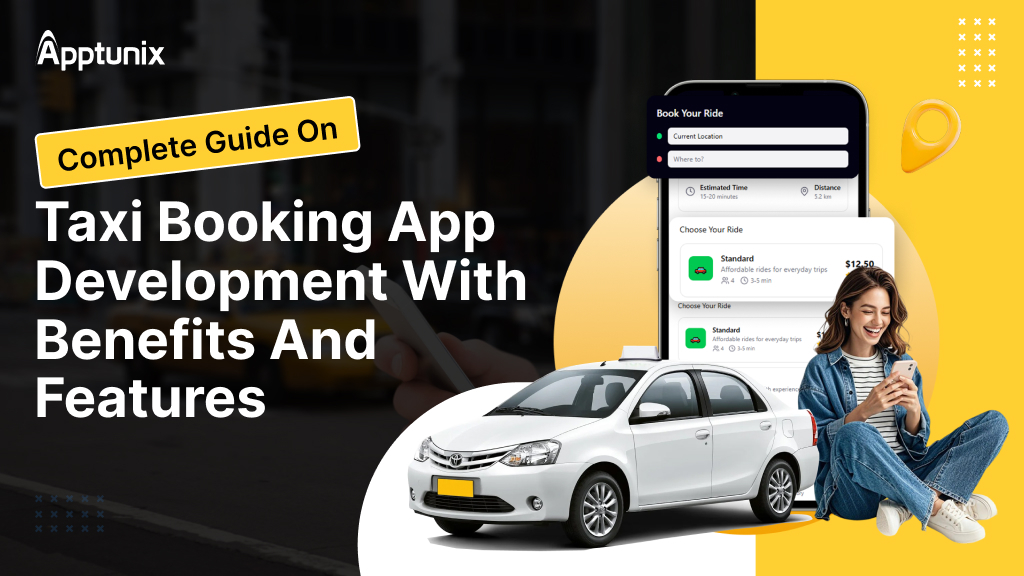
Urban mobility has transformed into one of the fastest-growing digital economies, with taxi booking platforms at its heart. By 2026, the global ride-hailing and taxi market is projected to reach $390 billion, with an annual growth rate of nearly 5.4%. For businesses, taxi booking app development is about creating local solutions that serve untapped markets with the right mix of technology, trust, and scalability.
The demand isn’t slowing down because customers now expect rides to be just a tap away.
Look at Uber, Lyft, and Careem. They’ve not only reshaped city transport but have also created billion-dollar ecosystems that continue to inspire entrepreneurs worldwide.
Whether you’re an entrepreneur looking to launch a taxi app or planning to modernise your fleet, the opportunity is wide open. A well-built taxi booking platform can build recurring revenue streams and position your business as a credible player. Let’s dive deep into this!
The global shift toward digital mobility has made taxi booking app development one of the most profitable ventures for startups and fleet operators. Let’s break down why this industry is worth your investment. Localized taxi booking platforms in regions like the Middle East and Asia are witnessing annual growth rates of 7–10%, proving that the opportunity is not just global but hyperlocal too.
People are moving away from traditional taxi stands and phone bookings, shifting to app-based solutions powered by intelligent taxi dispatch software.

People like to hire a cab from the comfort of their own home and wait for the taxi to arrive at their doorway while sitting on their couch. People may now order a cab from one location to another using a variety of excellent taxi applications such as Uber, Lyft, Grab, and Careem.
Which taxi app, though, is the best? It must be difficult to pick one app from a list of possibilities and order a cab with a single click. So, don’t be concerned. We’ve compiled a list of the top taxi apps based on their offerings, good comments, and popularity.
This Silicon Valley business, based in San Francisco, has revolutionized the definition of on-demand cab booking applications throughout the world. Uber is now present in over 700 locations across 65 countries.
Uber has grown in popularity due to factors such as its user-friendly interface, the availability of drivers and cars, simple payment choices, ride safety measures, country-specific features, and several cab rental models.
Lyft was launched in San Francisco, California, in 2012. It provides services in over 220 cities around the country, including Vietnam, the Philippines, Thailand, Singapore, Malaysia, and Indonesia.
A taxi app ola began as an online taxi aggregator in Mumbai in 2010 and now has a network that spans India, Australia, New Zealand, and the United Kingdom (169 locations) with over 100,000 vehicles. This app is well-known for providing a wide range of cab services via its smartphone app.
Grab was founded in 2011 and is well-known in the Philippines, Indonesia, Vietnam, Thailand, Singapore, and Malaysia. They want to make taxis a safe and efficient mode of transportation.
Easy Taxi is a Brazilian taxi company that operates in over 30 countries. It was founded in 2011. With millions of users all across the world, the taxi booking app development has been a huge success. It comes with a variety of features that make it a viable taxi booking app development in today’s world.
Check Out Top 13 Taxi Booking App Development Companies (2026 Rankings)
The success of any taxi booking app development project depends on how well it balances the needs of riders, drivers, and administrators. Features are not just checkboxes; they directly influence adoption, retention, and long-term revenue. If your taxi booking platform doesn’t cover these essentials, you’ll struggle to compete with giants like Uber, Lyft, or Careem.
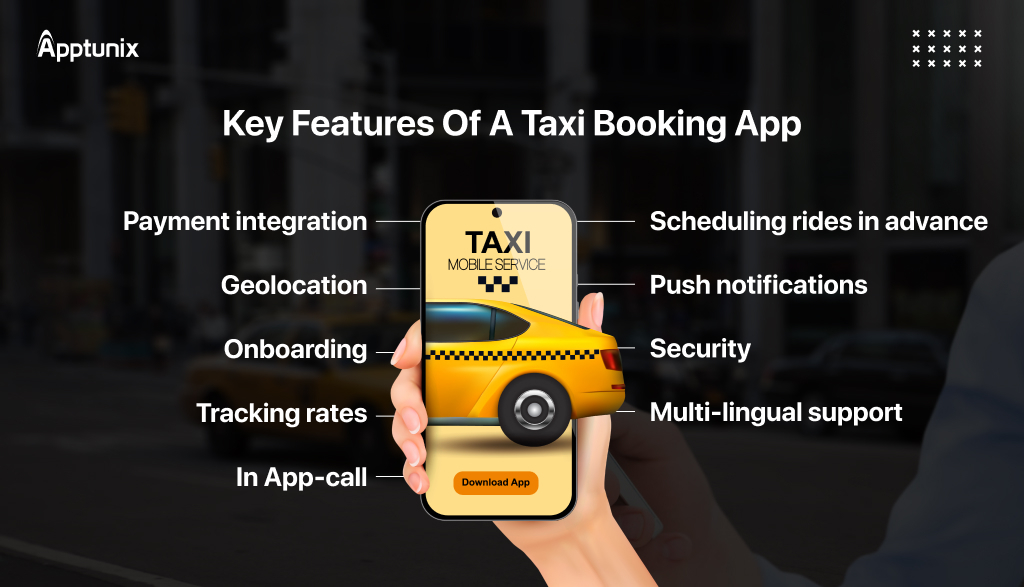
Passengers are the end users, and their experience defines the success of your business. Without these features, passengers quickly move to a competitor’s taxi booking platform. The features of a taxi app must make booking easy, safe, and reliable:
For a taxi booking app development company, driver satisfaction is as important as passenger satisfaction. If your drivers aren’t motivated, ride fulfillment will suffer.
A growing fleet demands structured management. That’s where taxi dispatch software becomes vital.
Going beyond the basics makes your app more appealing than a generic Uber clone app. High-performing readymade taxi app solutions often come with:
| Feature Category | White Label Taxi App Solution | Custom Taxi Booking App |
|---|---|---|
| Passenger Features | Pre-built, tested, ready to launch | Fully customizable, longer build time |
| Driver Features | Standard set with option to add modules | Tailored to unique fleet needs |
| Admin Dashboard | Pre-integrated taxi dispatch software | Built around enterprise workflows |
| Add-ons | Available as plug-ins or modules | Designed from scratch, higher cost |
| Time to Market | 3–6 weeks | 6–12 months |
| Scalability | Moderate to high, depending on vendor | Unlimited but requires higher investment |
Asking about the cost to build a taxi app is like asking how much a house costs. It depends on the size, design, location, and extras you want. The same applies to taxi booking app development cost. Costs vary depending on whether you choose a white label taxi app solution or a fully custom-built taxi booking platform.
Licensing white label ride-hailing software
If you start with a readymade taxi app solution, you’ll usually pay a one-time license fee or a subscription. Licensing keeps upfront costs lower and lets you launch quickly.
Customization and feature upgrades
Adding more than the standard features of a white label taxi app will increase costs. Loyalty programs, advanced analytics, or multi-city support all require extra configuration.
Hosting, maintenance, and support
A taxi booking platform is not a one-time build. Server costs, bug fixes, upgrades, and 24/7 technical support should be part of your ongoing budget.
Marketing and scaling expenses
Even the best taxi app development company can’t guarantee success if nobody downloads your app. Driver recruitment, rider acquisition campaigns, and compliance costs in new cities are often underestimated.
Here’s a realistic view of the investment required for taxi booking app development in 2025–26, starting from the UAE market:
| Type of Solution | Estimated Cost (UAE & Global) | What’s Included |
|---|---|---|
| Basic White Label Taxi App | $3,000 – $10,000 | Passenger, driver, and admin apps with essential features |
| Customized Readymade Taxi App Solution | $12,000 – $25,000 | White label ride-hailing software with branding, add-ons, and integrations |
| Full Custom Taxi Booking Platform | $40,000 – $50,000+ | Custom architecture, unique features, and advanced scaling support |
A white label taxi app solution minimizes time-to-market and keeps investment lower. Startups and small fleet owners often choose this route to validate demand before scaling.
A custom-built taxi booking platform is a bigger investment but gives enterprises total control over workflows, integrations, and UI/UX. It’s a long-term play for businesses with complex operations.
Even with a clear estimate, there are costs many businesses overlook:
If you plan wisely with your taxi app development company, these won’t surprise you later.
Time-to-market can determine whether you grab market share or lose it to competitors. The duration of taxi booking app development depends heavily on whether you choose a white label taxi app solution or invest in custom taxi app development.
Timeline with a Readymade Taxi App Solution
Businesses that need speed often prefer a readymade taxi app solution. These are pre-built, fully functional, and only require branding and basic configuration. A white label ride-hailing software can typically go live within 4–6 weeks, making it ideal for startups who want to test markets quickly.
Timeline for Fully Custom Taxi App Development
Custom-built apps are designed from scratch, with complete control over design, features, and integrations. They offer maximum flexibility but require more time. A full taxi app development process for custom builds can take 5–12 months depending on scope, complexity, and integrations.
The choice ultimately comes down to your business priorities. If speed and cost are your main drivers, a white label solution is the fastest way to launch. If scalability, unique features, and long-term ownership matter more, custom development is the better investment.
Choosing between a white label taxi app solution and a fully custom build is one of the most important decisions in the taxi app development process. The right choice depends on your goals, timeline, and budget.
| Factor | White Label Taxi App Solution | Custom Taxi Booking Platform |
|---|---|---|
| Launch Time | 3–6 weeks | 6–12 months |
| Cost to Build a Taxi App | $3,000 – $25,000 | $40,000 – $50,000+ |
| Features | Standard set with add-ons | Fully customizable |
| Scalability | Good for regional markets | Unlimited, built for enterprises |
| Best For | Startups, SMEs, fleet owners | Enterprises, multi-city operators |
A white label ride-hailing software is a readymade taxi app solution designed by a taxi app development company that you can brand as your own. It comes with pre-built features of a white label taxi app such as real-time tracking, driver dashboards, and dispatch management.
Pros:
Quick launch, often in weeks
Lower cost to build a taxi app
Tested features with fewer bugs
Easy to rebrand with your logo and theme
Cons:
Limited flexibility in deep customizations
Features may be standard across competitors
A custom app is built from scratch by an on-demand app development company to match your exact requirements. You define workflows, UI/UX, and integrations.
Pros:
Complete control over features and design
Highly scalable for enterprise growth
Competitive differentiation is easier
Cons:
Much higher upfront investment
Longer development timeline (6–12 months)

Startups and small fleets: A white label taxi app solution is often the smarter choice. It helps you validate your idea without burning your budget. You can always scale later.
Enterprises and large operators: If you’re running fleets across multiple cities or aiming to compete with established players like Uber, a custom-built platform is worth the investment.
Great ideas don’t succeed without a clear execution plan. Taxi booking app development follows a structured process that takes your concept from paper to a fully functioning platform. Whether you’re working with a taxi app development company or using a taxi app builder platform, these steps remain the foundation for building a strong product.
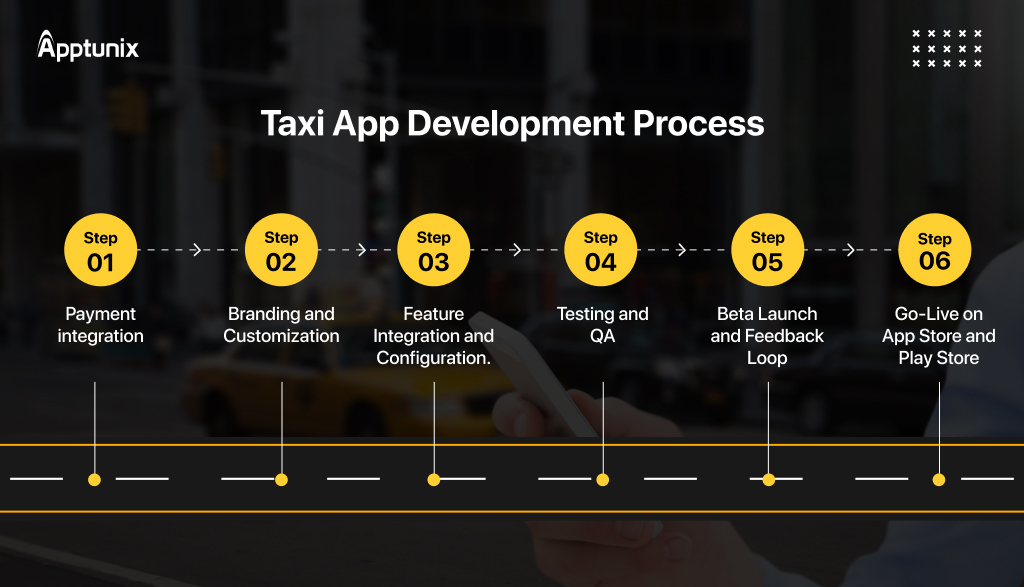
The first step is understanding what your market needs. Are you targeting a single city or planning a multi-country launch? Do you want an Uber clone app or a specialized on-demand ride-sharing app for corporate users? At this stage, businesses define their business model, target users, and revenue models for taxi apps.
Your taxi booking platform is not just an app, it’s your brand identity. White label taxi app solutions allow you to customize logos, colors, and design to align with your company’s branding. Custom builds go deeper, giving you complete flexibility over UI/UX, feature set, and integrations.
This is where technology meets business goals. Developers integrate core features such as GPS tracking, payments, driver verification, and taxi dispatch software. Add-ons like loyalty programs, SOS buttons, or corporate account support can also be configured depending on your target audience.
No taxi app development process is complete without quality assurance. Testing ensures that the app works smoothly across iOS, Android, and web, while handling multiple booking requests, payments, and notifications without issues.
A soft launch with limited users helps validate your product. This stage is critical for gathering driver and passenger feedback before going live at scale.
The final stage involves deploying the app on marketplaces, optimizing app store listings, and ensuring your marketing strategy aligns with user acquisition goals. A good on-demand app development company also provides post-launch monitoring and support for performance optimization.
A taxi booking platform is only as strong as the revenue model behind it. If you’re investing in taxi booking app development, you need to think beyond just launching the app. The real question is: how will your platform consistently make money while staying attractive to both drivers and passengers?
This is the backbone of most on-demand ride-sharing apps. Uber, for example, takes anywhere between 20% and 30% commission on each ride depending on the market. Careem follows a similar model in the Middle East. For startups, commission-based revenue is simple to set up and highly scalable. As ride volumes increase, your earnings grow automatically without renegotiating with drivers.
Surge pricing has proven to be a major revenue driver for Uber, Lyft, and other leading taxi booking platforms. A 2023 Statista report noted that over 40% of Uber’s peak-hour revenue comes from dynamic pricing adjustments. By raising fares when demand is high, platforms not only increase profitability but also incentivize drivers to log in when they are most needed. This ensures better service availability while maximizing margins.
Instead of taking a commission, some taxi booking platforms charge drivers or fleet owners a monthly subscription fee. This approach works well in regions like India and parts of Africa, where drivers prefer keeping their fare earnings intact. For example, Ola experimented with fixed subscription models for driver partners, which created stable recurring revenue streams for the company. If you’re entering a price-sensitive market, this model can make your app more appealing to drivers while giving you predictable income.
Once your platform scales, advertising becomes a lucrative revenue stream. Think of Grab in Southeast Asia earns millions by running targeted ads from restaurants, e-commerce brands, and fintech providers inside its app. Local businesses are often willing to pay premium rates for exposure to daily commuters. A growing passenger base transforms your taxi dispatch software into a valuable marketing channel.
Not every passenger is looking for the cheapest ride. Uber Black and Careem Business cater to corporate travelers, while eco-friendly options like EV rides are gaining popularity worldwide. According to McKinsey, premium ride services can command 2x to 3x higher margins than standard rides. Adding luxury cars, intercity travel, and subscription-based corporate tie-ups can diversify your taxi app’s revenue beyond everyday city commutes.
👉 The takeaway: The best-performing taxi booking apps don’t stick to just one revenue model. They combine commissions, surge pricing, partnerships, and premium services to build diverse and resilient income streams.
A common question entrepreneurs ask is whether the ride-hailing market is already saturated. The truth is that taxi booking app development remains highly profitable in 2026, particularly in emerging regions like the Middle East, Asia, and Africa where demand is growing faster than global averages.
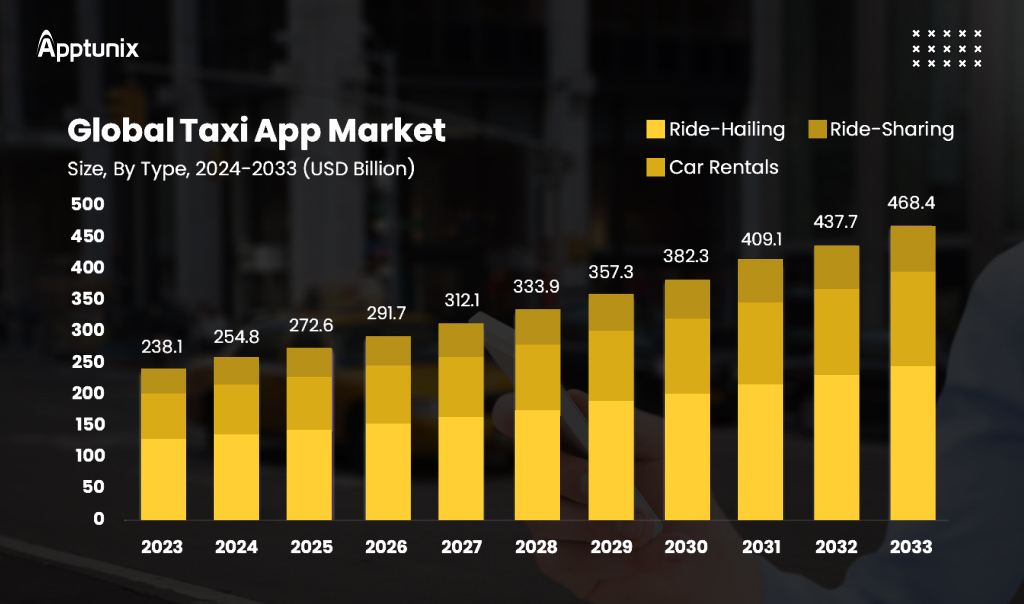
The global ride-hailing and taxi market is projected to reach $285 billion by 2030 (Statista), driven by urbanization, traffic congestion, and smartphone penetration. In the UAE alone, the ride-hailing segment is expected to grow at 12% CAGR between 2025 and 2030, making it one of the most attractive regions for new players. This growth creates a steady runway for businesses entering the market with scalable taxi booking platforms.
The real profitability lies in carving out niches that global giants overlook. For instance, EV-based services are growing rapidly, supported by government incentives in the UAE and Saudi Arabia. Similarly, women-only ride-hailing services have gained traction in markets like Egypt and India, building trust and loyalty in untapped segments. Luxury fleets and intercity travel also present higher-margin opportunities compared to standard city rides. With a readymade taxi app solution, you can adapt quickly to these niches without investing in lengthy custom builds.
Yes, Uber, Lyft, and Careem dominate headlines. But local players continue to thrive by aligning with cultural preferences, pricing models, and community trust. For example, InDriver, which lets riders negotiate fares, grew rapidly in Asia and Africa by targeting value-conscious users that Uber wasn’t serving. White label ride-hailing software enables startups to launch competitive services quickly at a fraction of the cost, narrowing the gap with larger brands.
One of the biggest advantages of using a white label taxi app solution is speed to market. Instead of spending $70,000+ and 12 months building from scratch, startups can launch in 4–6 weeks with as little as $3,000 in licensing fees. Many of these apps start generating positive cash flow within the first 3–6 months by combining commission-based earnings, subscription models for drivers, and surge pricing strategies. For fleet owners, the ROI is even stronger since the software optimizes utilization of existing vehicles.
When businesses think about taxi booking app development, they often wonder whether a new entrant can really compete with giants like Uber or Bolt. Here’s a real-world example that proves it’s possible. The client approached Apptunix with a clear vision: launch a scalable, Uber-like ride-hailing platform that could grow city by city.
They needed:
We engineered Rapid Cabs, a white-label taxi booking platform built for growth.
Within months of launch, the results were impressive:
Rapid Cabs is live on the Google Play Store, proving how a focused strategy and the right technology partner can turn a vision into a thriving business. This case study shows that with the right on-demand app development company, even newcomers can build taxi booking platforms that rival global leaders. A white-label taxi app solution not only accelerates launch but also creates space for long-term scalability.
Building a taxi booking app is about creating a business that wins rider trust, keeps drivers motivated, and generates steady revenue in a competitive market. That’s why more and more entrepreneurs are turning to white label taxi app solutions. They let you launch fast, keep costs under control, and start earning from day one. For startups, it’s the easiest way to test the waters and grow without burning through capital. And if you’re thinking long-term, you can always scale into a fully custom taxi booking platform once your business starts gaining traction.
The real question is how quickly you can move and speed matters. The sooner you launch, the sooner you build a customer base, gain driver loyalty, and carve your space before competitors catch on.
This is where a trusted partner makes all the difference. At Apptunix, we’ve helped taxi startups, fleet owners, and enterprises worldwide turn ideas into profitable ride-hailing businesses.
Your taxi booking empire starts here—let us help you launch faster, scale smarter, and succeed bigger.

Get the weekly updates on the newest brand stories, business models and technology right in your inbox.
Book your free consultation with us.
Book your free consultation with us.





